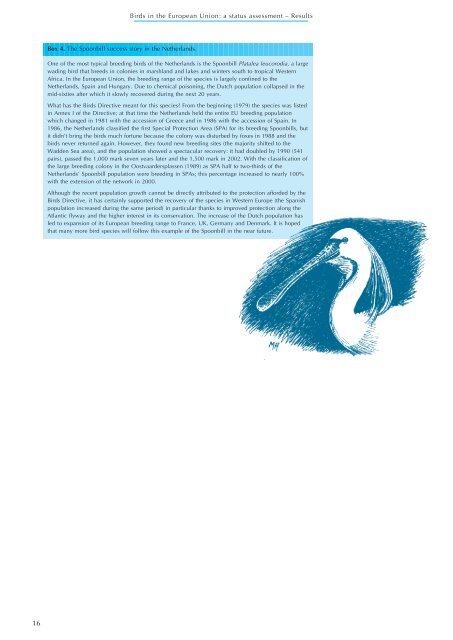Birds in the European Union - BirdLife International
Birds in the European Union - BirdLife International
Birds in the European Union - BirdLife International
You also want an ePaper? Increase the reach of your titles
YUMPU automatically turns print PDFs into web optimized ePapers that Google loves.
16<br />
Box 4. The Spoonbill success story <strong>in</strong> <strong>the</strong> Ne<strong>the</strong>rlands.<br />
<strong>Birds</strong> <strong>in</strong> <strong>the</strong> <strong>European</strong> <strong>Union</strong>: a status assessment – Results<br />
One of <strong>the</strong> most typical breed<strong>in</strong>g birds of <strong>the</strong> Ne<strong>the</strong>rlands is <strong>the</strong> Spoonbill Platalea leucorodia, a large<br />
wad<strong>in</strong>g bird that breeds <strong>in</strong> colonies <strong>in</strong> marshland and lakes and w<strong>in</strong>ters south to tropical Western<br />
Africa. In <strong>the</strong> <strong>European</strong> <strong>Union</strong>, <strong>the</strong> breed<strong>in</strong>g range of <strong>the</strong> species is largely conf<strong>in</strong>ed to <strong>the</strong><br />
Ne<strong>the</strong>rlands, Spa<strong>in</strong> and Hungary. Due to chemical poison<strong>in</strong>g, <strong>the</strong> Dutch population collapsed <strong>in</strong> <strong>the</strong><br />
mid-sixties after which it slowly recovered dur<strong>in</strong>g <strong>the</strong> next 20 years.<br />
What has <strong>the</strong> <strong>Birds</strong> Directive meant for this species? From <strong>the</strong> beg<strong>in</strong>n<strong>in</strong>g (1979) <strong>the</strong> species was listed<br />
<strong>in</strong> Annex I of <strong>the</strong> Directive; at that time <strong>the</strong> Ne<strong>the</strong>rlands held <strong>the</strong> entire EU breed<strong>in</strong>g population<br />
which changed <strong>in</strong> 1981 with <strong>the</strong> accession of Greece and <strong>in</strong> 1986 with <strong>the</strong> accession of Spa<strong>in</strong>. In<br />
1986, <strong>the</strong> Ne<strong>the</strong>rlands classified <strong>the</strong> first Special Protection Area (SPA) for its breed<strong>in</strong>g Spoonbills, but<br />
it didn’t br<strong>in</strong>g <strong>the</strong> birds much fortune because <strong>the</strong> colony was disturbed by foxes <strong>in</strong> 1988 and <strong>the</strong><br />
birds never returned aga<strong>in</strong>. However, <strong>the</strong>y found new breed<strong>in</strong>g sites (<strong>the</strong> majority shifted to <strong>the</strong><br />
Wadden Sea area), and <strong>the</strong> population showed a spectacular recovery: it had doubled by 1990 (541<br />
pairs), passed <strong>the</strong> 1,000 mark seven years later and <strong>the</strong> 1,500 mark <strong>in</strong> 2002. With <strong>the</strong> classification of<br />
<strong>the</strong> large breed<strong>in</strong>g colony <strong>in</strong> <strong>the</strong> Oostvaardersplassen (1989) as SPA half to two-thirds of <strong>the</strong><br />
Ne<strong>the</strong>rlands’ Spoonbill population were breed<strong>in</strong>g <strong>in</strong> SPAs; this percentage <strong>in</strong>creased to nearly 100%<br />
with <strong>the</strong> extension of <strong>the</strong> network <strong>in</strong> 2000.<br />
Although <strong>the</strong> recent population growth cannot be directly attributed to <strong>the</strong> protection afforded by <strong>the</strong><br />
<strong>Birds</strong> Directive, it has certa<strong>in</strong>ly supported <strong>the</strong> recovery of <strong>the</strong> species <strong>in</strong> Western Europe (<strong>the</strong> Spanish<br />
population <strong>in</strong>creased dur<strong>in</strong>g <strong>the</strong> same period) <strong>in</strong> particular thanks to improved protection along <strong>the</strong><br />
Atlantic flyway and <strong>the</strong> higher <strong>in</strong>terest <strong>in</strong> its conservation. The <strong>in</strong>crease of <strong>the</strong> Dutch population has<br />
led to expansion of its <strong>European</strong> breed<strong>in</strong>g range to France, UK, Germany and Denmark. It is hoped<br />
that many more bird species will follow this example of <strong>the</strong> Spoonbill <strong>in</strong> <strong>the</strong> near future.

















